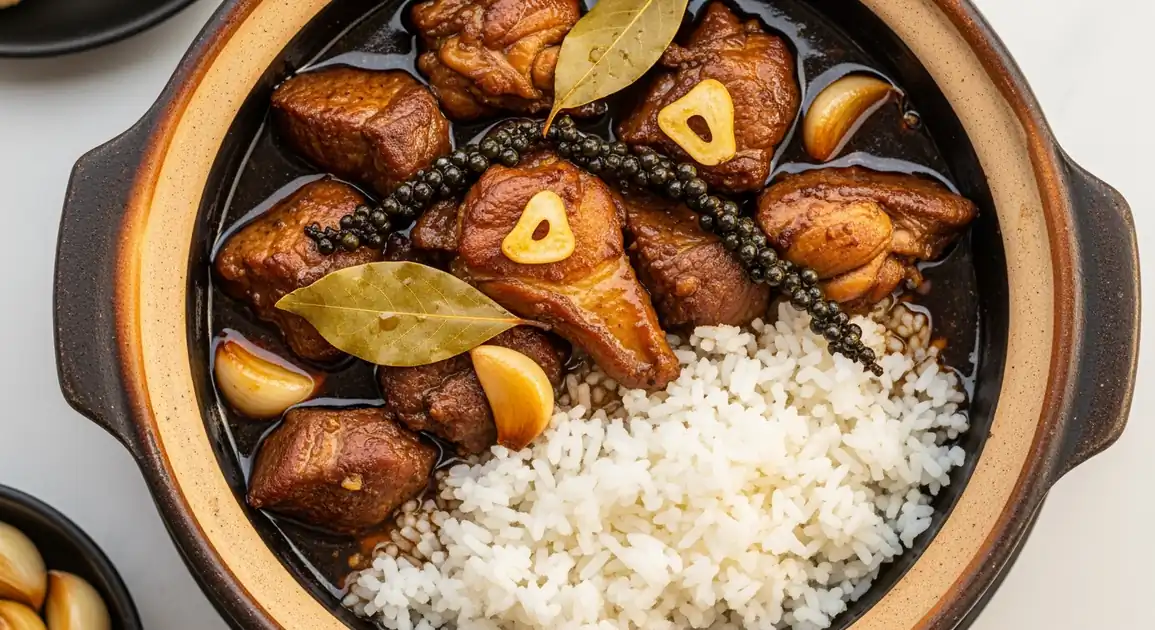Adobo
Adobo

Description
In Manila, the bustling capital of the Philippines, adobo represents the convergence of traditional Filipino cooking and modern culinary innovation. From humble carinderias to upscale restaurants, Manila offers countless interpretations of this national dish, ranging from strictly traditional preparations to creative, chef-driven variations that push boundaries while respecting the dish's soul.
Dietary Information
Serving information
Serving style
Served in various ways depending on the establishment: in clay pots (palayok) at traditional restaurants, on sizzling plates at more modern venues, or in simple plastic/metal containers at carinderias. Always accompanied by rice.
Quick facts
Carinderias: 7 AM - 8 PM. Restaurants: 10 AM - 10 PM. Select restaurants in Makati, BGC, and tourist areas may serve until midnight or later.
Safety Tips
What to Look For
-
Properly cooked meat that falls off the bone (chicken) or is fork-tender (pork)
Fully cooked meat ensures safety while achieving the ideal adobo texture. The meat should be tender but not mushy.
-
Clear, glossy sauce with visible whole spices
Quality adobo has a reduced, somewhat glossy sauce from rendered fat. The presence of whole peppercorns and bay leaves indicates traditional preparation.
-
Food served hot or properly refrigerated and reheated
While adobo's vinegar and salt act as preservatives, proper temperature control remains important, especially in hot climates.
-
Clean serving environment with proper food handling
Look for vendors who use clean utensils, covered containers, and good hygiene practices.
What to avoid
-
Pre-cooked adobo sitting at room temperature for extended periods
Despite its preservative qualities, adobo should not sit at room temperature all day, especially in hot weather.
-
Excessively oily or greasy appearance
While adobo naturally contains fat, excessive oil floating on top may indicate poor preparation or quality issues.
-
Very dark, almost black sauce
Extremely dark sauce may indicate overuse of soy sauce, burnt garlic, or old, repeatedly reheated adobo.
-
Adobo with an overly sour or fermented smell
While adobo should be tangy, an extremely sour smell might indicate spoilage or poor-quality vinegar.
Price information
Price range
Budget tips
- University belt carinderias around España, Recto, and Sampaloc offer student-friendly prices (90-150 PHP).
- Food courts in malls like SM or Robinson's have affordable adobo options (120-180 PHP).
- Jollijeeps (street food stalls) in Makati's business district serve quick, inexpensive adobo lunches.
- Set meals ('value meals') often include rice and a side dish.
Value indicators
- Proper meat-to-sauce ratio.
- Tender, flavorful meat (not tough or dry).
- Aromatic sauce with visible spices.
- Generous portions.
- Served with proper rice (not too dry or wet).
- Complementary sides or soup.
Where to Find This Dish
Binondo (Manila Chinatown)
Home to some of the oldest restaurants serving Filipino-Chinese fusion adobo styles.
Lucky Chinatown Mall, Binondo Church, Ongpin Street
Lunch (11 AM - 2 PM), Dinner (6 PM - 9 PM)
Makati
Business district with options ranging from street food to upscale Filipino restaurants.
Greenbelt, Glorietta, Salcedo Village, Poblacion
Lunch (12 PM - 2 PM), Dinner (7 PM - 10 PM)
Malate/Ermita
Tourist area with restaurants showcasing traditional Filipino cuisine.
Robinsons Place Manila, Adriatico Circle, Remedios Circle
Lunch (11 AM - 2 PM), Dinner (6 PM - 10 PM)
University Belt
Budget-friendly eateries serving students and locals.
University of Santo Tomas, Far Eastern University, San Beda University
Lunch (11 AM - 1 PM), Afternoon (3 PM - 6 PM)
Vendor Tips
- Look for places with 'Lutong Bahay' (home-cooked) signs for more authentic adobo.
- At carinderias, check if the adobo is freshly cooked or recently replenished.
- Restaurants that specialize in regional Filipino cuisine often have unique adobo variations worth trying.
- In Manila, many established restaurants are known specifically for their adobo - ask locals for recommendations.
How to Order
Regional Variations
-
Manila-style Adobo
(Adobong Maynila)
Often characterized by a balanced sauce that's neither too dry nor too soupy, with a good soy sauce-vinegar equilibrium.
-
Upscale Adobo
(Adobong Sosyal)
Found in Manila's high-end Filipino restaurants, featuring premium ingredients like organic free-range chicken, heritage pork, or specialty vinegars.
-
Fusion Adobo
(Adobong Fusion)
Creative interpretations found in Manila's modern restaurants, including adobo tacos, adobo pasta, adobo pizza, adobo sushi, and adobo burgers.
-
Chinese-Filipino Adobo
(Adobong Tsinoy)
Versions influenced by Chinese-Filipino cooking, often incorporating star anise, mushrooms, or Chinese cooking wine.
Cultural context
History
Adobo's origins blend pre-colonial Filipino cooking methods with influences from Chinese traders (soy sauce) and Spanish colonizers (who named it after their own 'adobar' marinade). Before Spanish contact, Filipinos were already cooking meat in vinegar and salt. The addition of soy sauce came later through Chinese trade. While the Spanish named the dish, Filipino adobo remains distinctly different from Spanish or Latin American versions. Through generations, adobo evolved with regional variations across the 7,000+ Philippine islands, becoming a cultural touchstone that reflects the country's complex history of indigenous practices and foreign influences.
Local significance
In Manila, adobo represents both tradition and innovation - a dish that connects urbanites to their provincial roots while evolving with the city's dynamic food scene.
Eating customs
- In Manila restaurants, adobo is often eaten with a local side dish like ensaladang talong (eggplant salad) or atchara (pickled papaya).
- Some Manila locals enjoy adobo with calamansi (local citrus) squeezed over the meat.
- Urban Manila dwellers often debate which regional adobo style is superior.